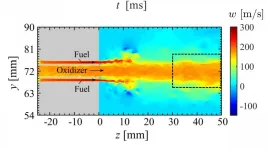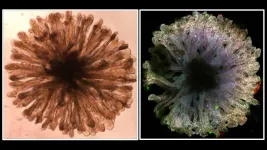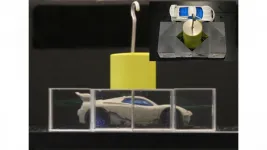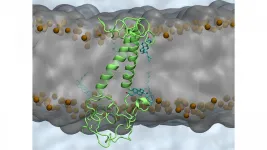Fuel flow, heat fluctuations drive dangerous oscillations in rocket engines
Power source clusters near rocket engine fuel injectors could create combustion oscillations
2021-06-15
(Press-News.org) WASHINGTON, June 8, 2021 -- Combustion engines can develop high frequency oscillations, leading to structural damage to the engines and unsafe operating conditions. A detailed understanding of the physical mechanism that causes these oscillations is required but has been lacking until now.
In Physics of Fluids, by AIP Publishing, research from the Tokyo University of Science and the Japan Aerospace Exploration Agency clarifies the feedback processes that give rise to these oscillations in rocket engines.
The investigators studied simulated combustion events in a computational model of a rocket combustor. Their analysis involved sophisticated techniques, including symbolic dynamics and the use of complex networks to understand the transition into oscillatory behavior.
The symbolic dynamics techniques allowed the scientists to determine similarities in behavior between two variables that characterize the combustion event. They found a relationship between fluctuations in the flow velocity of the fuel injector and fluctuations in the heat release rate of the combustor.
A rocket engine uses injectors to deliver a fuel, typically hydrogen gas, H2, and an oxidizer, oxygen gas, O2, to a combustion chamber where ignition and subsequent combustion of the fuel occurs.
"Periodic contact of the unburnt H2/O2 mixture with high-temperature products of the H2 [and] air flame gives rise to significant fluctuations in the ignition location," said author Hiroshi Gotoda.
Fluctuations in the ignition location produce fluctuations in the heat release rate, which affects pressure fluctuations in the combustor.
"We found that the heat release fluctuations and pressure fluctuations synchronize to each other," said Gotoda.
The product of the pressure and the heat release rate fluctuations in the combustor is an important physical quantity for understanding the origin of combustion oscillations. Regions where this product is greater than zero correspond to acoustic power sources that drive the oscillations.
The investigators discovered power sources in the shear layer near the injector rim. These power sources would suddenly collapse and reemerge upstream in a periodic fashion, leading to oscillations in combustion.
"The repetition of the formation and collapse of thermoacoustic source clusters in the hydrodynamic shear layer region between the inner oxidizer and outer fuel jets plays an important role in driving combustion oscillations," said Gotoda.
The investigators believe their analysis method will lead to a better understanding of the dangerous oscillations that sometimes arise in rocket engines and other combustors.
INFORMATION:
The article "Formation mechanism of high-frequency combustion oscillations in a model rocket engine combustor" is authored by Satomi Shima, Kosuke Nakamura, Hiroshi Gotoda, Yuya Ohmichi, and Shingo Matsuyama. The article will appear in Physics of Fluids on June 8, 2021 (DOI: 10.1063/5.0048785). After that date, it can be accessed at https://aip.scitation.org/doi/full/10.1063/5.0048785.
ABOUT THE JOURNAL
Physics of Fluids is devoted to the publication of original theoretical, computational, and experimental contributions to the dynamics of gases, liquids, and complex fluids. See https://aip.scitation.org/journal/phf.
[Attachments] See images for this press release:

ELSE PRESS RELEASES FROM THIS DATE:
2021-06-15
For many, the Thale cress (Arabidopsis thaliana) is little more than a roadside weed, but this plant has a long history with scientists trying to understand how plants grow and develop. Arabidopsis was first scientifically described as early as the 16th century and the first genetic mutant was identified in the 1800s. Since the 1940s, Arabidopsis has increased in popularity within the scientific community, which continues to use it as a model system to explore plant genetics, development and physiology to this day.
One might expect that after decades of scientific scrutiny the structure of Arabidopsis had been fully documented, but a new study from scientists from The Pennsylvania State University, USA, has revealed that this humble plant still has some surprises. The researchers describe ...
2021-06-15
A team of scientists at the Keck School of Medicine of USC has created what could be a key building block for assembling a synthetic kidney. In a new study in Nature Communications, Zhongwei Li and his colleagues describe how they can generate rudimentary kidney structures, known as organoids, that resemble the collecting duct system that helps maintain the body's fluid and pH balance by concentrating and transporting urine.
"Our progress in creating new types of kidney organoids provides powerful tools for not only understanding development and disease, but also finding new treatments and regenerative approaches for patients," said Li, the study's corresponding ...
2021-06-15
What The Study Did: In this survey of 1,186 medical, graduate and health professional school faculty, more faculty considered leaving since the COVID-19 pandemic than before. Faculty with children, particularly female faculty with children, were more likely to consider leaving since the pandemic.
Authors: Susan A. Matulevicius, M.D., M.S.C.S., of the University of Texas Southwestern in Dallas, is the corresponding author.
To access the embargoed study: Visit our For The Media website at this link https://media.jamanetwork.com/
(doi:10.1001/jamanetworkopen.2021.13539)
Editor's Note: Please ...
2021-06-15
What The Study Did: Researchers examined whether a sweetened beverage tax in Philadelphia was associated with sustained changes in beverage prices and purchases of sweetened beverages and high-sugar foods two years after implementation of the tax.
Authors: Christina A. Roberto, Ph.D., of the University of Pennsylvania Perelman School of Medicine in Philadelphia, is the corresponding author.
To access the embargoed study: Visit our For The Media website at this link https://media.jamanetwork.com/
(doi:10.1001/jamanetworkopen.2021.13527)
Editor's Note: The article includes conflicts of interest ...
2021-06-15
What The Study Did: Focus groups were conducted with teenagers to examine their responses to exposure to online and media-based vicarious racism and to explore coping strategies that may be used to combat negative emotions.
Authors: Nia Heard-Garris, M.D., M.Sc., of Ann and Robert H. Lurie Children's Hospital of Chicago, is the corresponding author.
To access the embargoed study: Visit our For The Media website at this link https://media.jamanetwork.com/
(doi:10.1001/jamanetworkopen.2021.13522)
Editor's Note: The article includes conflicts of interest and funding/support disclosures. Please ...
2021-06-15
WASHINGTON, June 15, 2021 -- Optical cloaking allows objects to be hidden in plain sight or to become invisible by guiding light around anything placed inside the cloak. While cloaking has been popularized in fiction, like in the "Harry Potter" books, researchers in recent years have started realizing cloaks that shield objects from view by controlling the flow of electromagnetic radiation around them.
In the Journal of Applied Physics, by AIP Publishing, researchers from the Toyota Research Institute of North America examined recent progress of developing invisibility ...
2021-06-15
WASHINGTON, June 15, 2021 -- Alzheimer's disease is predominant in elderly people, but the way age-related changes to lipid composition affect the regulation of biological processes is still not well understood. Links between lipid imbalance and disease have been established, in which lipid changes increase the formation of amyloid plaques, a hallmark of Alzheimer's disease.
This imbalance inspired researchers from Aarhus University in Denmark to explore the role of lipids comprising the cellular membranes of brain cells.
In Biointerphases, by AIP Publishing, the researchers report on the significant role lipids may play in regulating C99, a protein within the amyloid pathway, and disease progression. Lipids have been mostly overlooked from a therapeutic standpoint, likely because ...
2021-06-15
A tickle in the nose can help trigger a sneeze, expelling irritants and disease-causing pathogens. But the cellular pathways that control the sneeze reflex go far beyond the sinuses and have been poorly understood. Now, a team led by researchers at Washington University School of Medicine in St. Louis has identified, in mice, specific cells and proteins that control the sneeze reflex.
"Better understanding what causes us to sneeze -- specifically how neurons behave in response to allergens and viruses -- may point to treatments capable of slowing the spread of infectious respiratory diseases via sneezes," said Qin Liu, PhD, an associate professor of anesthesiology and the study's senior investigator.
The findings are published June 15 in the journal ...
2021-06-15
Research led by the University of Kent and the STFC Rutherford Appleton Laboratory has resulted in the discovery of a new rare topological superconductor, LaPt3P. This discovery may be of huge importance to the future operations of quantum computers.
Superconductors are vital materials able to conduct electricity without any resistance when cooled below a certain temperature, making them highly desirable in a society needing to reduce its energy consumption.
Superconductors manifest quantum properties on the scale of everyday objects, making them highly attractive candidates for building computers which use quantum physics to store data ...
2021-06-15
In the heart there are two different subtypes of beta-adrenergic receptors - beta1 and beta2 - which are activated by the stress hormones adrenaline and noradrenaline. They both trigger the strongest stimulation of the heart rate and pumping capacity that we know of. The two subtypes are highly similar biochemically, but differ substantially in terms of their functional and therapeutic relevance.
Both receptor types can stimulate the heart in the short term, yet when the beta1 receptor is activated over a prolonged period of time, it has a range ...
LAST 30 PRESS RELEASES:
[Press-News.org] Fuel flow, heat fluctuations drive dangerous oscillations in rocket engines
Power source clusters near rocket engine fuel injectors could create combustion oscillations





